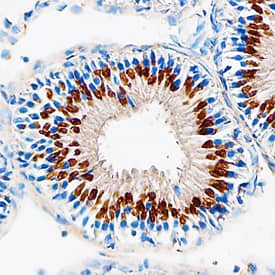Human/Mouse Polypeptide GalNAc Transferase 10/GALNT10 Antibody
R&D Systems, part of Bio-Techne | Catalog # AF7575

Key Product Details
Species Reactivity
Applications
Label
Antibody Source
Product Specifications
Immunogen
Leu71-Asn603
Accession # Q86SR1
Specificity
Clonality
Host
Isotype
Scientific Data Images for Human/Mouse Polypeptide GalNAc Transferase 10/GALNT10 Antibody
Polypeptide GalNac Transferase 10/ GALNT10 in Mouse Testis.
Polypeptide GalNac Transferase 10/GALNT10 was detected in perfusion fixed frozen sections of mouse testis using Sheep Anti-Human/ Mouse Polypeptide GalNac Transferase 10/ GALNT10 Antigen Affinity-purified Polyclonal Antibody (Catalog # AF7575) at 5 µg/mL overnight at 4 °C. Tissue was stained using the Anti-Sheep HRP-DAB Cell & Tissue Staining Kit (brown; Catalog # CTS019) and counterstained with hematoxylin (blue). Specific staining was localized to Golgi organelles in spermatocytes. View our protocol for Chromogenic IHC Staining of Paraffin-embedded Tissue Sections.Applications for Human/Mouse Polypeptide GalNAc Transferase 10/GALNT10 Antibody
Immunohistochemistry
Sample: Perfusion fixed frozen sections of mouse testis
Western Blot
Formulation, Preparation, and Storage
Purification
Reconstitution
Formulation
Shipping
Stability & Storage
- 12 months from date of receipt, -20 to -70 °C as supplied.
- 1 month, 2 to 8 °C under sterile conditions after reconstitution.
- 6 months, -20 to -70 °C under sterile conditions after reconstitution.
Background: Polypeptide GalNAc Transferase 10/GALNT10
GALNT10 (N-Acetyl-Galactosaminyl Transferase 10; also UDP-Acetylgalactosaminyltransferase 10 and ppGalNAc-T10) is a member of the GalNAC transferase subfamily, glycosyltransferase 2 family of enzymes. It is widely expressed, being found in intestine, pancreas, thyroid and spleen. GALNT10 is found in the Golgi apparatus, and catalyzes the transfer of UDP-GalNAc onto either a Ser or Thr residue on a previously glycosylated peptide/polypeptide backbone. Human GALNT2 is a 603 amino acid (aa) type II transmembrane glycoprotein. It contains an 11 aa N-terminal cytoplasmic region and a 572 aa extracellular domain (aa 32-603). The ECD possesses two key parts, a catalytic region with two catalytic subdomains (aa 144-253 and 311-373), and a ricin B-type lectin domain that binds carbohydrates (aa 458-590). These two distinct domains have unique but complimentary properties. By itself, an active catalytic domain can do no more than place a GalNAc residue immediately adjacent to an existing C-terminal GalNAC residue. Alternatively, if the lectin domain is involved, this domain may recognize (bind to) any number of existing glycosylation sites, allowing for the subsequent attachment of GalNAc by the catalytic site onto a Ser or Thr residue quite distant from the initial lectin domain:CHO recognition site. There are at least three potential splice form variants. One shows a deletion of aa 190-251, a second contains a 13 aa substitution for aa 354-366, and a third possesses a 23 aa substitution for aa 1-352 coupled to a three aa substitution for Asn389. Over aa 71-603, human GALNT10 shares 96% aa sequence identity with mouse GALNT10.
Long Name
Alternate Names
Gene Symbol
UniProt
Additional Polypeptide GalNAc Transferase 10/GALNT10 Products
Product Specific Notices for Human/Mouse Polypeptide GalNAc Transferase 10/GALNT10 Antibody
For research use only
